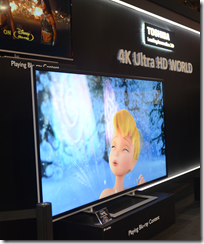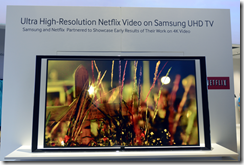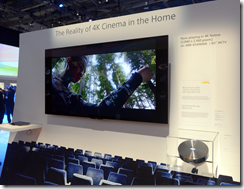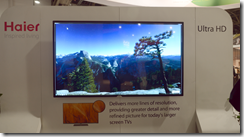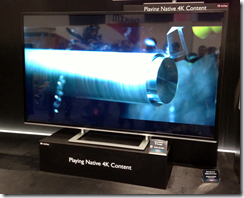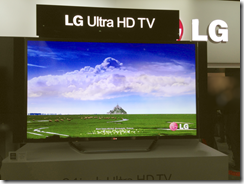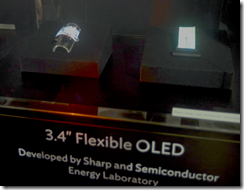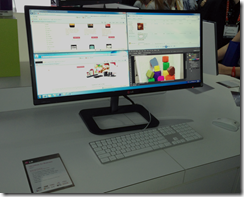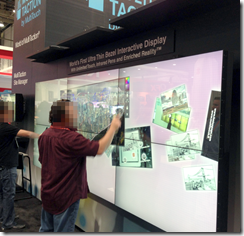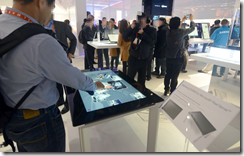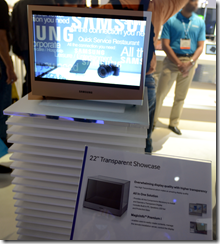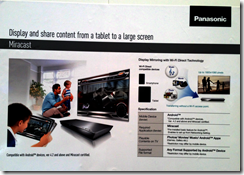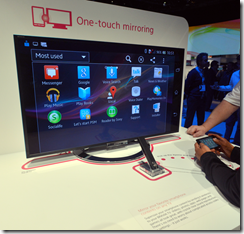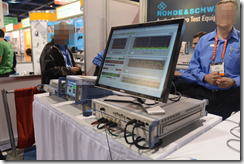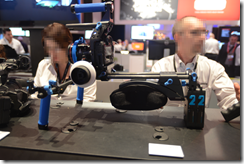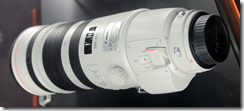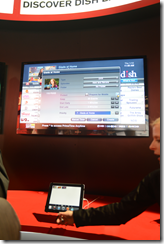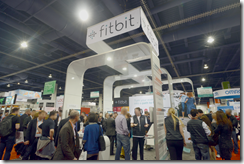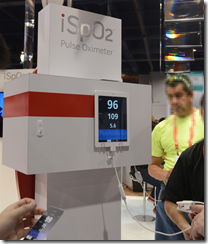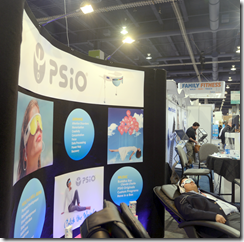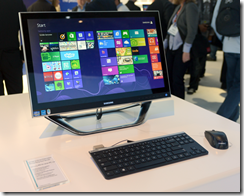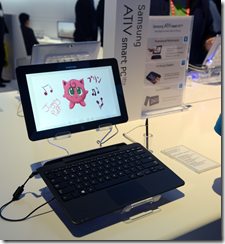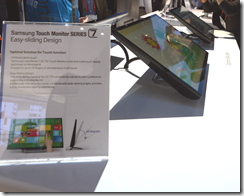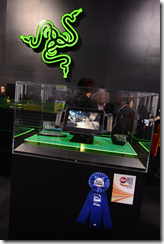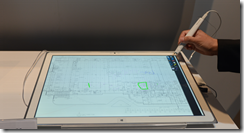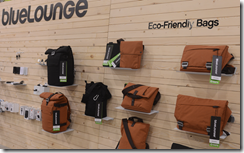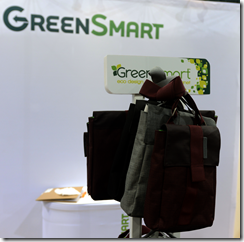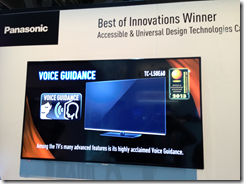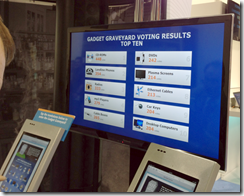Posts Tagged ‘report’
CES: Ingredients Not Just Products
 CES is an incredibly exciting and energizing show to attend. Sometimes, if you track some of the real-time coverage you might get a sense of disappointment at the lack of breakthrough products or the seemingly endless repetition from many companies making the same thing. There’s a good reason for all this repetition and it is how CES represents our healthy industry working well.
CES is an incredibly exciting and energizing show to attend. Sometimes, if you track some of the real-time coverage you might get a sense of disappointment at the lack of breakthrough products or the seemingly endless repetition from many companies making the same thing. There’s a good reason for all this repetition and it is how CES represents our healthy industry working well.
CES is best viewed not as a display of new products to run out and buy but as a display of ingredients for future products. It is great to go to CES and see the latest TVs, displays, or in-car systems. By and large there is little news in these in-market products and categories. It is also great to see the forward-looking vision presentations from the big companies. Similarly, these are good directionally but often don’t represent what you can act on reliably.
Taking an ingredients view, one (along with 140,000 others) can look across the over 2 million feet of 3,600 exhibitors for where things are heading (CES is one of the top trade shows globally, with CeBIT, Photokina, and Computex all vying for top ranking depending on how you count).
If you take a product view, CES can get repetitive or boring rather quickly. I probably saw a dozen selfie-sticks. After a while, every curved 4K TV looks the same. And certainly, there’s a limit to how many IP cameras the market can support. After a few decades you learn to quickly spot the me-too and not dwell on the repetition.
It is worth a brief description of why CES is filled with so many me-too (and often poorly executed) products.
Consider the trio of partners it takes to bring a product to market:
- Component suppliers. These are the companies that make a specific sensor, memory, screen, chipset, CCD, radio, etc.
- Manufacturers. These are the companies that pull together all the components and packaging needed to make a product. These are OEMs or ODMs in the consumer electronics industry.
- Brands and Channels. These are the consumer-visible manifestation of products and can be the chain of retailers or a retail brand.
At any one time, a new component, an innovation or invention, is close to ready to be in the market. An example might be a new heart rate sensor. In order to get the cost of the component low enough for consumer products, the component supplier searches out for a manufacturer to make a device.
While every supplier dreams of landing a major company making millions of units as a first customer that never happens. Instead, there’s a whole industry of companies that will take a component and build what you might think of as a product with a 1:1 mapping of that new component. So a low-cost CCD gets turned into a webcam with simple Wi-Fi integration (and often some commodity level software). The companies that make these are constantly looking to make new products and will gladly make a limited production run and sell at a relatively low margin for a short time. These initial orders help the component makers scale up manufacturing and improve the component through iteration.
At the same time there are retailers and brand names that are always looking to leverage their brand with additional products. These brand names often take the complete product from the manufacturer with some limited amount of branding and customization. This is why you can often see almost identical products with different names. Many know that a few vendors make most LED displays, yet the number of TV brands is quite high. There’s a small amount of customization that takes place in this step. These companies also work off relatively low margins and expect to invest in a limited way. For new categories, while the component companies get to scale out parts, the brands and channels get a sense of the next big thing with limited investments.
So while CES might have a ton of non-differentiated “products”, what you are really seeing is the supply chain at work. In fact it is working extremely well as this whole process is getting more and more optimized. The component manufacturers are now making proof of concepts that almost encroach onto the manufacturers and some brands are going straight to component makers. For the tech enthusiast these might be undifferentiated or even poor products, but for many they serve the purpose at least in the short-term.
Today, some things we take for granted that at one time seemed to swarm the CES show floor with dozens of low quality builds and me-too products include: cameras, flash memory, media playback devices, webcams, Wi-Fi routers, hard drive cages, even tablets and PCs. I recall one CES where I literally thought the entire industry had shifted to making USB memory sticks as there must have been 100 booths showing the latest in 128MB sticks. Walking away, the only thing I could conclude was just how cheap and available these were going to be soon. Without the massive wave of consumer me-too digital cameras that once ruled the show floor, we would not have today’s GoPro and Dropcam.
An astute observer can pick out the me-too products and get a sense for what ingredients will be available and where they are on the price / maturity curve. One can also gauge the suppliers who are doing the most innovative integrations and manufacturing.
Sometimes the whole industry gets it wrong. The most recent example of this would be 3D TV, which just doesn’t seem to be catching on.
Other times the whole industry gets excited about something but others take that direction and pivot it to much more interesting and innovative products. An example of this would be the run of “media boxes” to attach to your TV which went from playing content stored on your home network and local hard drives to stateless, streaming players like Google Chromecast, Amazon Fire and Apple TV. Without those first media boxes, it isn’t clear we would have seen the next generation which took that technology and re-thought it in the context of the internet and cloud.
Finally, the reality is that most of the manufacturers tend to take a new component and build out a purpose-built device to surround that component. So they might take a camera sensor and add a camera body and just make a point-and-shoot. They might take new flash storage and turn it into portable storage. They might take a new display and just make complete monitor. Rarely will the first generation of devices attempt to do multiple things or take a multi-year approach to integrated product development—not on those margins and timelines.
Some technologies this year that reflect first generation products and are likely to be brought to scale or further integrated with other components include: curved displays, high resolution/high DPI displays, human and environmental sensors, and HDR imaging. Sensors will be the most interesting as they will clearly be drawn into the SoC and/or integrated with each other. Obviously, everyone can expect Wi-Fi and broadband connectivity to continue to get smaller and easier and of course CPUs will continue to shrink, draw less power, and get faster.
So when you read the stories about CES saying there are too many junky products or so many of the exact same thing, don’t think of that as a negative. Instead, think about how that might be the next low-price, high-scale ingredient that will be integrated into your product or another product.
A product management view of CES 2014
 I love the Consumer Electronics Show. Maybe I’m numb from decades of attending it. Maybe I’m just too much of a fan of watching stuff get made. Maybe I just like long lines and the potential for airborne illness. Really what I love is the technology industry and that every year we get together and demo new products, share works in progress, and take chances on offering products people don’t yet (or ever) know they want. CES 2014 was an exceptionally unique year and one that I think will be remembered as the start of a new era, much how the 1970 show changed TV with the introduction of the VCR or the 1981 show changed music with the CD player.
I love the Consumer Electronics Show. Maybe I’m numb from decades of attending it. Maybe I’m just too much of a fan of watching stuff get made. Maybe I just like long lines and the potential for airborne illness. Really what I love is the technology industry and that every year we get together and demo new products, share works in progress, and take chances on offering products people don’t yet (or ever) know they want. CES 2014 was an exceptionally unique year and one that I think will be remembered as the start of a new era, much how the 1970 show changed TV with the introduction of the VCR or the 1981 show changed music with the CD player.
CES 2014 was an exceptionally unique year and one that I think will be remembered as the start of a new era.
But wait, you ask “What product was launched at CES 2014?” The answer is “None”. Instead, this is a year in which every product is about software, and every product assumed that the computer involved would be based on modern mobile platforms, and most everything connected to a cloud service. As an industry we’re not there yet, as we will talk about below, some offerings still cling to previous models of accessing computing and we’re likely to see much changing of the guard as breakthrough products emerge.
The ubiquity of the modern mobile platform, smartphones and tablets, might seem obvious to all of us in computing proper, but it took the better part of a decade for it to go from a section of the show to a big presence to woven into the fabric of every exhibitor. Likewise, software has gone from “content” to “console games” to “pc applications that get thrown in with a device” to the raison d’être or differentiation of consumer electronics.
So put aside the lines, the endless sameness of non-differentiated products, the puzzling keynotes, or even the absence of Apple and Google, and consider the over 3200 companies of all sizes showing off products of all kinds. For me, I think back to when I was a kid and the excitement around what was next came at the yearly Auto Show or reading about the historical World’s Fair Expos. It is hard to avoid concluding that CES is our era’s expression of the future—transportation, healthcare, communication, entertainment, and more are represented by the innovation on display at CES.
It is hard to avoid concluding that CES is our era’s expression of the future—transportation, healthcare, communication, entertainment, and more are represented by the innovation on display at CES.
Me, I’m just excited to get to go to the show and systematically walk up and down every aisle exploring what is there to see. My one set of eyes and one post can’t compete with the likes of the professional tech press that push out hundreds of posts during the week or with the amazingly thorough coverage of “best of” done by many.
Instead, I offer these observations or themes from a product development perspective—what would I be looking at as a product manager or engineer. As I’ve said in this blog many times, learning comes from observing and sharing. Product plans come from many points of view and sources coming together in the context of a company. I cover a lot, but there is more. It was a great show for learning and thinking about the next phase of our industry.
This report looks at themes covering embedded smarts, healthcare devices, communication wearables, screens (4K, curved, skinny), less futzing, and overall trends up/down.
First, a bit of humility
One thing required when looking at new products and technologies is humility. Even though many would like to differ, CES is not a shopping mall where you go to find the new big thing to buy or use right away. This is counter-intuitive because a lot of the products at CES are new and for sale. But in practice, they have not been used and many times not even released to reviewers yet. So you want to step back as you read about the products and not look through the lens of “would I buy and use this today” and instead think about the context overall. As part of that I like to remind myself of a few things about what we see:
- Companies aren’t dumb. A lot of times when a product is first seen something jumps out at you as totally wrong. Keep in mind many of the products are not about the use cases for today, but for use cases yet to be seen. The most classic example is the Walkman— a “tape recorder” that didn’t record. Or more recently, a digital camera that is bigger, heavier, costlier, and worse than a film camera. Sometimes the new use cases aren’t even obvious to the companies yet, and this is even more true today as many “hardware” companies are moving forward rapidly with hardware or the supply chain is making available new components because it can, neither really having software that can implement new use cases.
- Limitations seen in less than one minute are known by the product people. Every product has issues, limitation, constraints. Walking up to a brand new product and thinking you’re the first person to notice such is usually a mistake. While the person at the booth might know the FAQ, it is a good idea to assume the product folks back at HQ actually know the limitations. I can’t count how many times people commented on the battery life of one of the wearables with screens—as though the people developing them would not like to have a month of battery life or were not aware of the trade-off between weight and battery life.
- Iteration is baked into the product you are seeing. Even though the product is for sale, it might not be done yet. It will get smaller, faster, cheaper, power efficient, lighter, and more feature rich. It will do so quickly. Many of those plans are in place. Because so much of the hardware is now subject to Moore’s Law, it is already happening and you can just wait—the price of 4K displays will drop rapidly and because of 1080P volume the price is already spectacular compared to what we’ve come to expect based on previous generations. For software, we all know updates and features are part of the plan. There’s no guarantee things will go in the “right” direction for every product but iteration will happen. Because there are many players, keep in mind that iteration by one player becomes learning for another player so there is ample opportunity for changes in leadership. We all know in technology, first mover advantage is not necessarily an advantage. Multi-party, iteration is the reason.
- Core competency matters. With so many devices doing so many things and so many products incorporating features from other products for differentiation, it is important to focus on the core competency of a product. There’s a good chance a product will try to do too much or for that matter all the products will try to differentiate themselves based on some peripheral features. Don’t lose sight that TVs should have a good picture, fitness bands should measure your fitness well, scales should be fast and easy to read, speakers should sound good and so on.
- Everything has depth and experts. Every year I get surprised by some product that I never thought of and think how amazing that idea is, and then I see 3 more of them on the show floor. It is easy to forget that inside the CE industry there are many industries. Within those industries are people who spend their careers mastering something that, to the uninitiated, might seem narrow. I saw a modern blood sugar monitor (see below) this year that was totally unique. Then I saw two more. These experts are all feeding off many of the same inputs and so one should expect some degree of convergent innovation. Said another way, in the context of a broad show like CES, something that I think is really cool might not actually be all that innovative to those in the field with some domain knowledge.
Themes
Let’s look at some themes and within them put on our product manager hats and see how what we observed might influence our own choices in products design. I’m going to take the observations from the show floor and project forward a bit as that’s what product management needs to do with the data when there are technology bets to be made, products to design, and specs to write.
Embedded smarts
Intel kicked off the show with a keynote declaring that all devices need to be smart. Walking around the show floor showed that this advice has already been taken to heart. While smart TVs are the most obviously visible (and also a holdover from the past two or so years), we also saw smart cars, smart healthcare devices, smart fitness monitors, smart watches, smart home appliances, smart projectors, and more. Smart was everywhere. Should it be?
Smart can mean anything from a touch-based user interface replacing the existing mechanical UI to taking a formerly mechanical device and embedding an entire OS with app ecosystem into the device.
Moore’s Law is an important contributor to this trend. Previous views of smart devices would have meant connecting the hardware device to a PC, with all of the costs, size, power that this entails. Home automation that used to take a PC now just connects devices with Wi-Fi to a cloud service, for example. A home blood pressure monitor would have stored some number of readings until you connected it with a serial cable to a PC and now it just sends those over Wi-Fi to a cloud service. TVs would have been connected to a PC that presented a full PC experience through an alternate user interface that today can offer this same type of functionality through an entirely embedded solution. Now it is both feasible and economic to include an ARM-based computing platform and either a Linux or Android OS driving the “smarts”.
But is this always right? The product manager view might be that it is time to look at use cases and scenarios and step back. While the hardware side is possible, the software might not be delivering the right experience. The truth is, some devices should be dumb. And that’s ok. The internet of things does not need to recreate the challenges of the internet of PCs. A single general purpose approach used everywhere might not be the best approach compared to tailored devices working with a very rich mobile device and cloud services.
The truth is, some devices should be dumb. And that’s ok.
One reason for this is that there can only be so many app ecosystems. It simply won’t be possible for apps to be delivered reliably and in a feature complete manner across all of the various smart devices. While today it might be possible for a streaming music service to be omnipresent on every possible smart device from a watch to a car to a TV to a refrigerator to a treadmill (and a phone and a tablet), down the road the user experience for that streaming app will have become rich enough that the primary use case will drive the expected experience which won’t be duplicated across devices, whether that is because the devices vary in capabilities, screen sizes, or just human interaction or just because there are too many different platforms.
Two examples help to reinforce this product challenge.
- Screens / TV. We all want lots of stuff on our big screens. We want streaming video, live broadcast television, music (maybe), and perhaps some web services like messaging. But these are all sophisticated experiences (finding the video, dealing with TV signals/guides/DVR, managing playlists, different apps), and so it means they likely demand (or will demand) a rich interaction model connected to services. Good news! We already have this interaction model on our modern mobile tablets and phones. Why try to duplicate this with the added complexity and variety of TVs? Rather a device like Chromecast or Apple TV shows how you can use the TV simply as a “dumb screen” which becomes far more manageable, the UI is far better, and is a much better overall experience. These solutions, where the screen is dumb and the mobile device serves as the gateway to the dumb screen seem to put the code in the right place and reduce complexity and increase simplicity for the use case. It is worth asking if this Twitter client on a TV will ever match what you can do on your mobile device in your hand while watching the show? That’s not to say there won’t be other use cases integrating apps into TV, but just showing subsets of the mobile apps side by side doesn’t seem right.
- Autos. From Audi to Volvo we saw smarts added to cars. This was added in the form of a screen, a telemetry platform, and apps. What is different about this compared to TVs is that we don’t want cars to be dumb. We want cars to be smart about being cars (safety, maintenance, better driving and accident avoidance). Like TVs, however, it isn’t clear that we want to put the equivalent of a unique mobile platform in every car brand. Is there any chance the mapping app in a car will be on par with the mapping app in my mobile device? Wouldn’t I rather have the same ability to send my mobile screen to the car screen that I get with Chromecast or Apple TV? Perhaps having a protocol that supports touch in that scenario is very helpful too. In the meantime the smarts of the car can focus on the things the car needs to do, and perhaps even recognize the best way to have a user experience and manage those would be with an app and cloud service? Ultimately, the way cars are made means that the technology choices are out of date by the time the car makes it to market and if you own the car for 5 years then those technology choices are really dated and perhaps the overall resale value of the car declines.
Will this UX really be right today or in 8 years?
The fact that all the screens and cars are making bets on technologies that are just capable of being used helps us all—this is not the time to be cynical but the time to learn. These products are not done yet and we can’t highlight the greatness of the Lean Startup and MVP and then be critical of bringing to market products that might not quite be done—that’s where reviews, experts, and frankly store return policies can help. As a product manager you want to ask yourself about the trajectory and likelihood of success of an approach down the road when the work all comes together. These new products show exciting scenarios but maybe there are better ways to implement them.
Healthcare devices
The advances in sensors have been breathtaking thanks to technologies like MEMS and others. Combining those with the ability to embed and whole OS and connectivity to cloud services in what used to be basic diagnostic equipment is a revolution in healthcare. Here too we saw many new and breakthrough products. As a telemetry nut, obsessive compulsive, and geek these are some of the most exciting products ever. One thing that made this CES seem so new and fresh is that this feels like a renaissance in consumer electronics. Devices you buy at reasonable price points, solve specific problems like an appliance, and just work for a scenario. In most ways, these new devices are starting to deliver now.
Basic body telemetry like weight, blood pressure, composition and more can now be easily measured, tracked over time, and even shared easily with care givers or compared with a circle of friends. Stepping on a scale every morning is quietly making a bar chart, setting alerts, and trending your data. And even better, such devices are learning from past designs and becoming easier to setup and use. No longer do you need a PC, EXE, and USB cable. Instead the device is paired over Bluetooth with a dedicated app and you’re up and running with a great UI in no time. Basic scenarios like maintaining compliance with medication are made easier by smart pill boxes that alert you wirelessly on your mobile device to take medicine. Overkill? Perhaps, but compliance rates are still not where they need to be. And combine this with easy measurement of blood pressure and you can see how putting smart in the right place, cloud services and mobile apps to make things accessible can be such a huge advance.
Three healthcare products that demonstrate this include:
- Head injury. Much has been written about the rise in head injury in sports and long term risk associated with cumulative concussion, particularly football. Reebok with the Checklight is one of many companies with a product designed to measure cumulative head impact using accelerometers. The packaging is very user friendly as you can see (and it won a best of CES award). The basics of the device are cool—a red light goes off when a certain level of cumulative concussion risk has been reached. Other variants of similar devices have different form factors (helmet integrated, mouth guard) and can even report real time to a mobile app. The telemetry, use case, and execution are all coming together at CES 2014.
- UV exposure. The JUNE UV detection bracelet by netamo simply measures cumulative sun exposure and integrates with a mobile app, again with a simple UI on the device and a data connection to a mobile app. There’s a lot to like about this for folks who work or play outdoors and want to mitigate the risk of skin disease or damage. The app/service provides advice and a suggested “routine” for your skin based on data.
- Blood glucose. Those that have been touched by diabetes (perhaps one of the more insidious diseases in the developing world, costing the US an estimated $245B a year in healthcare and related costs) know the complexity and challenges of testing and managing glucose levels. The YoFi Meter, http://www.yofimeter.com/, is a very smart device (see the above discussion). It combines a glucose test strip dispenser/reader, a lancet dispenser, along with a simplified tracking interface on a touch screen and an integrated 3G connection to a cloud data service. This is a device that takes compliance to a new level. At first I might have thought this device is too smart, and then after talking to the designer I learned of many use cases where a companion mobile phone isn’t available or possible (for example, students must be tested by the nurse who doesn’t have time to call up parents with real time data and a phone might not be available in school).
Each of these three devices shows how telemetry and mobile apps/cloud services can dramatically change the basics of healthcare for a scenario.
There are challenges we will all need to deal with however. These challenges are not new to those who already work with data. Data does not always lead to actionable next steps and sometimes more data leads to more ambiguity. These three devices show how the reality is that science is not yet caught up to being able to present us with all this data.
In the case of concussion and head injury, right now the data is unclear on how much cumulative impact over what period of time is “safe”. So while it can be measured, exactly when and how to act is not clear, particularly for children. It is easy to see how the debate will quickly move to one of acceptable levels. So more studies over a longer period of time will be needed which for this type of measurement will take decades given that the measurement is just now available. Science is hard. Glucose measurement is the other end of the spectrum. For diabetics the data and management is well understood, but compliance is challenging or at least not super convenient. The advances are amazing and ready now! Sun exposure is one that becomes interesting only because the data basically says to minimize exposure as much as possible—in other words there’s not really an acceptable level of UV light (i.e. SPF 40, see http://www.aad.org/media-resources/stats-and-facts/prevention-and-care/sunscreens).
Together these show the opportunities and challenges in the healthcare telemetry space. In any product design, the ability to measure something and present the measurement to a customer is not the same as being able to provide reliable and actionable information. It is critical in the design of a product to be clear on what to do when the product tells you something, lest the dreaded “Check Engine’ syndrome.
One might even offer the world’s first connected toothbrush:
Wearable communication
While many healthcare devices are wearable, the broader category itself exploded this year as has been well documented…everywhere. When it comes to sophisticated wearable communication devices, this is a year of learning products. Most are not ready for primetime or broad usage, though many will find niches with early adopters or enthusiasts.
This shouldn’t be news to anyone. Consider as an example post-VHS digital formats for movies forays into optical media (LaserDisc anyone), the path from first products to broadly used products is often one with many twists and turns in basic technology and scenarios. In addition that path from the first component sized DVD player to the 6″ round portable DVD player or integrated flat screen DVD player took some time. Innovation does not happen all at once, even though we often remember it as punctuated moments in time.
There’s no need to document the dozens of communication wearables on display. Most shared the same basic characteristics, with Pebble being the established player that has already earned an enthusiastic base of early adopters. These pair with a mobile device, share notifications, and permit some level of interactivity and apps/ecosystem. Some do less and trade off towards a longer battery life by doing less. Others try to subsume the mobile device entirely and act as a phone (see below).
The primary “cause” of this is that the ability to miniaturize the hardware platform and squeeze a full software platform on the device has surpassed the ability to build a software experience and use case. These devices, by and large, are currently in the “because we can” phase of innovation. That’s not bad and in fact when software meets hardware it is often a necessary ordering.
The primary challenge, at least from my perspective, is that no one has arrived at a new use case. We’re simply looking to move some use cases of the mobile device to a wrist based device. But the device on the wrist is “less of everything”. Taking a disruption point of view, this isn’t disruptive yet. As often discussed, the first PC-derived tablets were more PCs without keyboards than they were a new set of use cases (pen based drawing/notetaking notwithstanding). It wasn’t until the iPad presented a new set of mobile scenarios and capabilities and the hardware was better able to meet the scenarios that a device without a keyboard was able to define a new use case.
Absent a use case, the dialog around wearables will just bounce around the constraints of screen size and battery life. You can only do so much with a tiny screen and a wrist sized device can only operate a screen for so long. While one likes to be notified with a UX based on a glance, it turns out this is pretty much what mobile phone designers work to do all the time and with a lot more screen real estate and elaborate UX. On those platforms the debate is an endless one around how much can you do to a notification and what are the verbs that act on it. Is a new text just read, read and reply with a canned set of replies (and can/how might those be customized), or full messaging capabilities? Do those choices extend to custom messaging apps like WhatsApp or Skype? Who will write those apps? When those apps have new features do they carry over to the wrist?
Here is one example of a fitness watch that is also full smartphone on a wrist, including a pull out Bluetooth headset.
This is a complex set of questions. From a product manager perspective, they all boil down to defining use cases and scenarios for why a device should exist. Is it a companion? Is it a replacement? What does it do uniquely such that I’d be willing to forgo other functions I already have? Disruption theory says that it is totally ok for a new product to do less, so long as it is so good at something that people want more as that’s the whole point of being disruptive.
It is still early. It is too early to judge these devices as what is possible and for most of us too early to be adopting these devices. They are the stuff of Star Trek, which by that theory of innovation only means it is a matter of time.
Screens: 4K, curved, and skinny
If you’ve seen just one article on CES then it is certain you know that new TVs on display were both 4K and curved. Cutting to the chase, if you buy a TV in 2015 odds are it will be 4K. The rapid march to 4K is more massive than anything we’ve seen in screens. Moore’s Law is our friend here and at some point the entire supply chain will just convert to the mechanics of making 4K and it becomes essentially non-economic to maintain the old processes and supply chain. We’ve seen this with memory, storage, processors, and screens. Silicon based innovation lends itself to rapid and whole movement of products. That’s good for all of us.
Cutting to the chase, if you buy a TV in 2015 odds are it will be 4K.
For screens, 4K has two unique elements:
- Extremely rapid cost reduction. Competition is fierce and the economics of the processes will likely drive 4K screens to “acceptable” consumer prices much more quickly than the move to flat screen or 1080P. During the show Dell announced a 4K monitor for $699. My early adopter 15″ VGA LCD costs $1999 (and weighed more than the Dell will). Yay for consumers!
- Content will appear. While we can all bemoan the hype and failure cycle of 3D at home, which included a lack of content, there were already significant content deals for 4K, notably Netflix. While you need 15MB bandwidth for 4K the content will be there. Rest assured, the rest of the content industry heard this and so I suspect we will see brilliant 4K content of some form very rapidly. Again, yay for consumers!!
If you have any doubts, once you see a 4K screen you will want one. Put aside all the arguments about physics, optics, and more, it just feels right. In practice, what you really want are high gamut and 60fps, so let’s hope these attributes and benefits become clear to consumers. Again, this shows the value of reviews, community, and expertise in the adoption of CE.
Curved screens were somewhat of a surprise to many attendees I believe. In booth after booth people had somewhat puzzled looks at them and there seemed to be a broad effort to quiz the booth staff with “so what good is it”. Most of the time we all got the general answers about immersive experience or less reflection. Each of these to some degree are true (especially reflectivity in many situations).
Again, as product managers we see a hardware technology appear because it can but the use case hasn’t yet been determined. Like the first color computer screens that many argued against claiming software was inherently black and white, curved screens are about new use cases not just curving a football game. One view around CES and you can easily see scenarios such as signage that become incredibly cool. Today signs that are interactive are much cooler than static signs (or menus and more). Signs that need to be on curved surfaces are static and boring. Maybe curved displays will be a niche at home and find themselves useful only for commercial signs. I’m going to bet on the creativity of content and product people to develop new use cases and before we know it curved screens will be ubiquitous as “flat screens”.
Finally, this year saw a great many more wide-aspect ratio screens at 21:9. For the most part, the mass market of screens are made in a small set of aspect ratios depending on mass adoption. Like film was historically, there are both benefits to this along with those that want to experiment with alternate aspect ratios. The iOS tablet world is 4:3 and the Windows/Android/HD world is 16:9. The ultra-wide 21:9 seems rather appealing for a number of use cases, including side by side and multiple inputs. If you combine the ultra-wide screen, more pixels, and curved display you recreate a developer workstation or Bloomberg terminal but with a single screen which can mean less space, easier ergonomics, and perhaps less power. Again, it seems like the use cases are going to quickly follow the technical ability to make the screen.
The product manager view of screens is to consider what you app or content can do when being projected on or making content for these new capabilities. As we saw with Retina pixel density, these changes can happen quickly and getting left behind is not always a good spot to be.
Less futzing
The evolution of most CE devices is often to more features and customization, and over time this can be viewed negatively. Certainly at some point this complexity makes products unappealing for many. The industry has a great many enthusiasts who love to customize and tweak. Analogous to the auto shows, some people used to love to look under the hood and adjust the engine.
Back in the heyday of Auto Shows (they are still huge, but CES and tech have eclipsed those shows in media coverage in my biased view), the talk was about components of cars. This dialog was broad and understood. Average consumers knew about horsepower, disc brakes, electronic fuel injection. Today cars are about design, convenience, and use-centric concepts like capacity and MPG. CES, this year in particular, has transitioned to talking and showing more about use cases and less about how products are built.
In almost all devices you have to look hard to find gigahertz or megabytes. You see tasks or uses much more up front. This isn’t always the case and often the first questions are about specs. Still, I would say a lot of “progress”.
Some examples of this jumped out at me, particularly in the gaming world. The gaming world has traditionally been split between consoles representing the true CE experience and the gaming PC which defined the ultimate enthusiast experience when it came to moding your gaming PC. For gamers or those that want to just play games this is a banner time with an explosion in gaming options. Many believe the usage in phones and tablets will dominate with casual games available in app stores. The new consoles from Sony and Microsoft promise to bring gaming to new technical levels with their advanced PC componentry in a true CE package. Finally, at CES we saw the SteamOS powered devices (PCs) and an example of a more state of the art or “modern” PC.
Steam Machine. SteamOS promises to bring the simplicity of consoles with the power of PC gaming. Some critics are saying it brings neither and is in-between. But the popularity of the Steam platform is significant with millions of intensely active members. The product manager question is whether Steam disrupts PC (or console) gaming or simply extends the life of a gaming platform that while popular is being squeezed between consoles and mobile devices. Is the SteamOS powered device re-imagination of PC gaming or an appealing convergence of the PC with consoles (see https://blog.learningbyshipping.com/2014/01/07/the-four-stages-of-disruption/)?
A Steam Machine is an Intel-based device meeting a set of baseline specs, combined with the Steam Controller and SteamOS. The debate among gamers is about the specs and capabilities of the underlying hardware along with the lack of ability to mod the devices. The Steam Machines themselves represent a broad range of “sealed case” form factors, most of which existed as Windows game PCs in various forms.
Razer Project Christine. Razer introduced Christine, which is a highly stylized modular PC. While the idea behind a modular from factor has been tried several times before, the combination of hardware interop, industrial design, and openness to accessorization (my own word) are at a unique point in time. Razer has a very active customer based that thrives the combination of gaming and accessories for gaming. It might just be that this hassle-free notion of moding a gaming PC will appeal to a broad set of PC gaming customers. In many ways this is an attempt to disrupt the PC gamer, while maintaining a commitment to customization. Project Christine beat out Steam Powered for CES Best of Show in the category.
Reduced futzing is really enabled across a broad range of CE devices because of mobile apps, WiFi/Bluetooth connectivity, and cloud services. What used to be elaborate setup and configuration is now enabled via simple apps that connect to devices over wireless protocols. The rich UX afforded by devices replaces single line LED displays or embedded web server experiences. The ability to save/restore data and settings in the cloud replaces sharing via dedicated (and awkward) subset experiences for social networks. From WiFi access points to scales to cameras, we will spend (and tolerate) less time futzing and more time using CE devices.
From a product manager perspective what excites me about these two innovations and the broader theme is the move “up the stack”. Our computing industry has broadly moved to modern platforms for both hardware and software and seeing gaming move in this direction is critical to the health of this style of rich interactive gaming. It is also a natural maturing of a technology area and to resist the change essentially guarantees disruption. The market for people willing to devote time to futzing is shrinking, no matter how much we (having built more PCs than I can count) enjoyed it. There are simply too many options for how to spend more time gaming and less time futzing. Just like people want to use cars to get around, not stare under the hood and fix them before going somewhere, the move up the stack is relentless for most every consumer.
Trending up and down
To wrap up a quick look at the year over year view of CES and what is on the move taking up more floor space and mind share and what is taking less beyond the items mentioned above.
Trending Up
Android. There was a lot more Android this year than last year. Android of course is particularly popular among wearables and TVs where there is no third party option to use iOS. The inexpensive Android tablets we all heard about from the holidays were on display where you could see the dozens of OEMs packaging every conceivable screen size and spec into tablets. One note is that there was a complete absence of 4:3 Android devices, which I find interesting given the competitive nature of things. What this feels like is a reaction to avoid being like Apple, when in practice it might be that for some device sizes the squarer aspect ratio might be more convenient.
Chromebooks. Building off what we might have read as momentum in the US over the holidays was a broader presence of Chromebooks. This year saw an all-in-one along with several lighter and thinner (and still inexpensive) clamshell formats.
Phablets. It was interesting to see the number of show attendees using their really big phones (or small tablets). I would do a quick badge check and noted that more often than not the phablet user was not an employee of Samsung or LG, but just a user. I think this is a trend worth watching. If you have only one device the tradeoff towards a bigger screen becomes interesting.
WWAN connectivity. Looking back personally, I was totally wrong on WWAN connectivity. I did not see a market where the carriers would make it so easy and relatively inexpensive to add another device to a data plan. From the glucose meter to auto fleet tracking to wearables, SIM cards were everywhere. This in spite of the fact that the hardware costs are real and the data plan is real. Many products, particularly those using WWAN for sending telemetry to a cloud service, will include a SIM and fixed data plan as part of the device price or part of the service plan, which is super cool.
3D Printers. The 3D printers are all remarkable. It is hard to overstate how much this will disrupt so many fields. There’s a lot of talk about a drone delivering a product, but what about just downloading it and printing it at home. The use cases for 3D printers are not at the broad consumer level but soon will be.
Touch screens. All the major screen makers also showed screens that were touch capable. The most common touch detector was an IR field. All of these were hooked up to PCs. Every screen is a touchscreen or it feels broken. Also pictured below is Panasonic’s 4K portable running Windows.
Trending Down
PCs. While Microsoft, HP, Dell, and others having stopped exhibiting on the main show floor can easily be responsible for the lack of PCs, the reality is that PCs are part of the fabric of the technology world, but not the front and center consumer electronics device. The reality of the floor is that PCs were not part of the use cases or scenarios and the modern mobile platforms have taken over. This image below sort of summed it up. Here we had RCA showing their new PCs (fairly thick and heavy laptops) in a booth with toasters and dorm refrigerators. Yet we all know, today, the products at the show were built using PCs, the businesses are run with PCs, and even the show itself would not be possible without PCs. The focus is just changing.
Discs. There are no optical discs to be found, for storage or content. Content comes from the cloud. Content is stored in the cloud. This was the last show with discs, and they were practically not there. One might say the same for spinning media and even the satellite tuners were offering solid state storage options to reduce noise, size, and thermals.
Projectors. Another reminder of Moore’s Law as applied to glass is that absence of projectors. While there are quite a few very tiny portable projectors, by and large projectors have been replaced by simpler and brighter on wall displays (soon to be curved and 4K).
Wires. There’s almost no wire at CES anymore. Even the Monster cable booth was mostly about cleaning screens and wireless headsets more than wire. As a person who has no wired communications at home, I can relate.
Home Theater. After a decade or more of “home theater”, the drive to simplicity, the role of streaming content, unified HDMI, and the preference for mobile, has all but eliminated the idea of a complex, multi-component, theater. Today’s theater experience is so much different than emulating a movie theater in a dedicated room at home using a projector and stack of 1000 watt components. People want to watch TV but also interact at the same time and that leads to a very different environment. With the ability to watch anything instantly on a tablet, a home theater has some strong competition for attention and use cases. The lack of a need for a home media library of discs or drives also alters the need for a dedicated room. Live events and film fans still will have their dedicated experiences, but the equipment is drastically simpler.
Remote controls. The world of complex infrared controls at home is being disrupted by mobile devices. Even infrared, while simple and low cost, feels like it will be disrupted by Bluetooth or even Wi-Fi.
For those in technology, CES is really the greatest show on earth. We’re all privileged to be part of the technology industry in such a pivotal time. Next year is going to be even better. I’m counting on it.
—Steven Sinofsky (@stevesi)
Bonus Photos
Tiny laptop level power supply that works by the magic of physics from Finsix in Menlo Park, CA:
A few hundred thousand dollars worth of add-ons to convert a Canon C500 into a studio broadcast camera:
Sony’s full family of Xperia Android devices is also water-safe. These are all worth a second look I believe.
Example use case for 4K screens with 4 up 1080P security cameras (also on the floor, 4K recording cameras):
Case for iPhone that embeds the ability to take infrared images. Another example of “possible, but still developing the core use case”. This was developed by FLIR, an existing maker of IR cameras:
Bluetooth headphones plus earmuffs in one.
Example use case for curved signage. Wouldn’t this be a more interesting booth with a moving sign:
10 Observations from Tokyo’s CE scene
 I love visiting Tokyo and have been lucky enough to visit dozens of times over many years. The consumer electronics industry has certainly had ups and downs recently, but a constant has been the leading edge consumer and business adoption of new technologies. From PCs in the workplace to broadband at home and smartphones (a subject of many humorous team meetings back pre-bubble when I clearly didn’t get it and was content with the magic of my BB 850!) Japan has always had a leading adoption curve even when not necessarily producing the products used globally.
I love visiting Tokyo and have been lucky enough to visit dozens of times over many years. The consumer electronics industry has certainly had ups and downs recently, but a constant has been the leading edge consumer and business adoption of new technologies. From PCs in the workplace to broadband at home and smartphones (a subject of many humorous team meetings back pre-bubble when I clearly didn’t get it and was content with the magic of my BB 850!) Japan has always had a leading adoption curve even when not necessarily producing the products used globally.
This visit was about visiting the University of Tokyo and meeting with some entrepreneurs. That, however, doesn’t stop me from spending time observing what CE is being used in the workplace, on the subway, and most importantly for sale in the big stores such as Yodobashi, Bic, and Labi and of course the traditional stalls at Akihabara. The rapid adoption, market size, and proximity to Korea and China often mean many of the products seen are not yet widely available in the US/Europe or are just making their way over. There’s a good chance what is emphasized in the (really) big retail space is often a leading indicator for what will show up at CES in January.
If you’re not familiar with Yodobashi, here’s the flagship store in Akihabara — over 250,000 sq ft and visited by 10’s of millions of people every year. I was once fortunate enough to visit the underground operations center, and as a kid who grew up in Orlando it sure feels a lot like the secret underground tunnels of the Magic Kingdom!
With that in mind here are 10 observations (all on a single page). This is not statistical in any way, just what caught my eye.
- Ishikawa Oku lab. The main focus of the trip was to visit University of Tokyo. Included in that was a wonderful visit with Professor Ishikawa-san and his lab which conducts research on exploring parallel, high-speed, and real-time operations for sensory information processing. What is so amazing about this work is that it has been going on for 20 years starting with very small and very slow digital sensors and now with Moore’s law applied to image capture along with parallel processing amazing things are possible such as can be seen in some of these Youtube videos (with > 5 million views), see http://www.youtube.com/ishikawalab. More about the lab http://www.k2.t.u-tokyo.ac.jp/index-e.html.

- 4K Displays. Upon stepping off the escalator on the video floor, one is confronted with massive numbers of massive 4K displays. Every manufacturer has displays and touts 4K resolution along with their requisite tricks at upscaling. The prices are still relatively high but the selection is much broader than readily seen in the US. Last year 4K was new at CES and it seems reasonable to suspect that the show floor will be all 4K. As a footnote relative to last year, 3D was downplayed significantly. In addition, there are numerous 4K cameras on sale now, more so than the US.
- Digital still. The Fuji X and Leica rangefinder digital cameras are getting a lot of floorspace and it was not uncommon to see tourists snapping photos (for example in Meiji Garden). The point and shoot displays feature far fewer models with an emphasis on attributes that differentiate them from phones such as waterproof or ruggedized. There’s an element of nostalgia, in Japan in particular, driving a renewed popularity in this form factor.
- Nikon Df. This is a “new” DSLR with the same sensor as the D-800/D4 that is packaged in a retro form factor. The Nikon Df is definitely only for collectors but there was a lot of excitement for the availability on November 21. It further emphasized the nostalgia elements of photography as the form factor has so dramatically shifted to mobile phones.
- Apple presence in store. The Apple presence in the main stores was almost overwhelming. Much of the first floor and the strategic main entry of Yodobashi were occupied by the Apple store-within-a-store. There were large crowds and as you often see with fans of products, they are shopping the very products they own and are holding in their hands. There has always been a fairly consistent appreciation of the Apple design aesthetic and overall quality of hardware but the widespread usage did not seem to follow. To be balanced, one would have to take note of the substantial presence of the Nexus 5 in the stores, which was substantially and well-visited.
- PCs. The size of the PC display area, relative to mobile and iOS accessories, definitely increased over the past 7 months since I last visited. There were quite a large number of All-In-One designs (which have always been popular in Japan, yet somehow could never quite leap across the Pacific until Windows 8). There were a lot of very new Ultrabooks running Haswell chips from all the major vendors in the US, Japan, and China. Surface was prominently displayed.
- iPhone popularity. There was a ubiquity of the iPhone that is new. Android had gained a very strong foothold over the national brands that came with the transition to nationwide LTE. Last year there was a large Android footprint through Samsung handsets that was fairly visible on display and in use. While the Android footprint is clearly there, the very fast rise of iPhone, particularly the easily spotted iPhone 5s was impressive. The vast expanse of iPhone accessories for sale nearly everywhere supports the opportunity. A driver for this is that the leading carrier (DoCoMo) is now an iPhone supplier. Returning from town, I saw this article speaking to the rise of iOS in Japan recently, iPhone 5S/C made up 76% of new smartphone sales in Japan this October.
- Samsung Galaxy J. Aside from the Nexus 5, the Android phone being pushed quite a bit was the Samsung Galaxy J. This is a model only in Asia right now. It was quite nice. It sports an ID more iPhone-like (squared edges), available in 5c-like colors, along with the latest QC processor, 5″ HD display, and so on. It is still not running Kitkat of course. For me in the store, it felt better than a Galaxy S. Given the intricacies of the US market, I don’t know if we’ll see this one any time soon. The Galaxy Note can be seen “in the wild” quite often and there seems to be quite a lot of interest based on what devices on display people would stop and interact with.
- Tablets. Tablets were omnipresent. They were signage in stores, menus in restaurants, in use on the subway, and in use at every place where people were sitting down and eating/drinking/talking. While in the US we are used to asking “where are all the Android tablets”, I saw a lot of 7″ Android tablets in use in all of those places. One wouldn’t expect the low-priced import models to be visible but there are many Japan OEMs selling Android tablets that could be spotted. I also saw quite a few iPad Minis in use, particularly among students on the trains.
- Digital video. As with compact digital cameras, there was a rather extreme reduction in the number of dedicated video recorders. That said, GoPro cameras had a lot of retail space and accessories were well placed. For example, there were GoPros connected to all sorts of gear/showing off all sorts of accessories at Tokyu Hand (the world’s most amazing store, imho). Professional HD and UHD cameras are on display in stores which is cool to see, for example Red and Arri. One of the neatest uses of video which is available stateside but I had not seen is the Sony DEV-50 binoculars/camera. It is pricey (USD$2000) but also pretty cool if you’ve got the need for it. They have reasonable sensors, support 3D, and more. The only challenge is stability which make sense given the equivalent focal length, but there is image stabilization which helps quite a bit in most circumstances.
There were many other exciting and interesting products one could see in this most wired and gadget friendly city. One always is on the lookout for that unique gift this holiday season, so I found my stocking-stuffer. Below you can see a very effective EMF shielding baseball hat (note, only 90% effective). As a backup stocking-stuffer, all gloves purchased in Japan appear to be designed with resistive touch screens in mind :-)
–Steven Sinofsky
PS: Here’s me with some super fun students in a class on Entrepreneurship and Innovation at the University of Tokyo.
Learning by Sharing: Snark-free CES 2013 observations
Wheels up, returning from CES. Seems like a good time to reflect and share some of my observations.
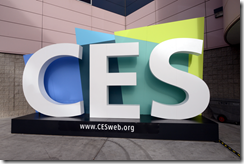
Sharing raw data is an important part of building a strong cohesive team. Raw data allows everyone on a team to see the inputs and thus map from there to the conclusions, whether those are new plans or course corrections to existing plans.
This post shares some observations about CES but first provides some context and practices for the ins and outs of trip reports in the context of product development.
Why do trip reports?
From the earliest days of business travel, my managers have required a trip report in exchange for the privilege of taking a trip at company expense. Whether you are a manager or not, sharing your observations and learnings from a trip (site visit, customer roundtable, trade show, conference) is a way of contributing to the shared understanding of products and technologies.
A report is just that—a collection of words and artifacts—and by itself it does not represent the follow up actions as those need to come from a process of taking the data from multiple perspectives and spending time thinking through implications. In fact, a point of failure in product development is over-reacting to the immediacy of a single trip report or point of view (no matter who on the team wrote the report). Those are anecdotes and need more work to turn them into actions like changing plans or features.
Practices
There’s no right way to create a report. More often than not the format, structure, and detail of a report should follow from the type of event. Do you organize by type of technology or by vendor, by customer or customer theme, by conference session or by technical subsystem, and so on?
Reports also don’t need to be short, especially if the trip was filled with information. If you want to offer a distillation at the bullet point level then there are a couple of options. For a public event you can often cite a blog or article (or two) that seems to match your perspectives. For a confidential event you should still do a detailed report and distribute as appropriate, but consider an oral version for members of the team. Bullet points can be good on their own to make key points and also may serve as an outline for the body of the report. The downside of providing only bullet points is that it might not share enough of the raw data and folks might think of what you shared more as conclusions. Keep in mind that the time spent writing the report is also time spent thinking more deeply about what you experienced.
I personally value the use of pictures quite a bit. For site visits showing the artifacts (example app screens, paper based systems, use of devices in context, photos of the physical environment) can be super helpful to highlight what you saw. For conferences, if there is a great slide or graphic from a session, showing that can help a great deal. And for tradeshows, showing off products is super fun. Video of course can be cool but introduces complexity in sharing in some formats.
There’s often a discussion on how much hyperlinking to do in a report (links to presentation PPTs, videos, or product information for example). It really depends on the need the readers/target will have to seek even more information. Obviously you should always be prepared to provide more information, but I don’t think it is a best practice for your report to be filled with blue underlines or missing data because everything is a click away. If you’re tracking hardware, for example, and some spec (wt, mHz, watt) is important then just include that in the report.
There are two aspects to confidentiality / intellectual property to respect when writing a report. First, always be careful to report on things you are permitted to write down and report on. You should ask permission for any photos (at customer sites or conferences, and even some tradeshow booths). Second, when you distribute your report make sure you are working within company policy on the way information is shared.
Whether you use email, attachments, a file share, OneNote on SkyDrive (to share with a small group), or a blog (internally hosted) really depends on your org’s culture. The blog format is great because then you have one place with all your reports so you can always know where they are no matter what type of report. The key is to just make sure, without spamming people, that the data is available for folks on the team – or your audience.
As a manager or leader on the team, it is always a good practice to remind folks that a trip report (unless specifically noted otherwise) is just anecdotal information and not a change in plans, a call to action, or anything beyond sharing. With the data from you and other sources, the right folks who are accountable should act. If you do have feedback then separate it from the report as a good practice.
About CES
Leading up to this year’s CES show, one might have thought the CE industry was in a lull and devoid of activity, let alone innovation, by reading a few of the pre-show reports. Nothing could be further from the truth. CES 2013 was another year of amazing things to see. More importantly, CES highlights the optimism that drives our industry. The pursuit of new products, new businesses, and most importantly combining those to come up with ways to simplify and improve life for people through electronics, hardware, and software.
It seemed to me that a good number of the early reports were a bit on the snarky side and reflected a view that there would not be any major disruptive or cool announcements. Folks were talking about a lull in innovation. I even read one blog post saying the industry was boring (I’ve met product people in most every industry and can honestly say they never think their own industry is boring).
Measuring innovation by what is new, shown, and/or announced for the first time at one of the world’s most massive tradeshows is not the right measure. Companies do not usually time their product development to coincide with tradeshows. Announcing a new product in a sea of thousands of other booths is not often the best communications strategy. In today’s world, announcements can be communicated broadly through a variety of channels and amplified socially at a time that fits the business.
Expecting a company to unveil something at the show is somewhat misplaced. On the other hand, a big part of CES, at least for me, is really being able to see any (large) company’s full product line “end to end” and to see how they are fitting pieces together to deliver on scenarios, value, or competition. Smaller companies have an opportunity to show off their products in a much more interactive fashion, often with very knowledgeable members of the team showing things off. Most importantly, CES lets you see “side by side” whole categories of products—you see the positioning, the details, and how companies present their products.
Unveiling a new product or technology that is a cross-industry effort, one involving many partners, does work particularly well at CES. Intel’s efforts around Ultrabooks, in 2012 and 2013, demonstrate this. While Intel’s booth and large scale presentations show off Windows 8 and Ultrabooks, the amplification that comes when seen on display at Sony, Samsung, LG, Toshiba, and more is where the sum of the whole is greater than the parts.
Many folks might not be aware, but along with the booths and all the semi-public displays, many companies conduct confidential briefings with press and partners at CES. These briefings might show off future products and strategies, but the reporters cannot write about what they see. In this case, CES is just convenient, especially for international press who don’t get to see US companies in person. It is an interesting approach because it can positively impact press coverage of already disclosed products when reporters know “phew, there’s more to come”. It could also frustrate, “hey I want to write about that”.
Writing a CES trip report is tricky for a non-reporter. Folks not there are following blogs and mainstream media and tens of thousands of stories are flowing out from LV. A tech blog might have 30-40 people on site and might file 300-400 stories from the floor—and that is just one outlet.
One person (me) can’t compete with that. But as a product development person, there’s a different lens—we’re looking at products and technologies as ingredients and competitors, not as things we’re looking to buy now. We are looking at trends and not necessarily the here and now. A way to think of it is that some go to CES as though it were a restaurant looking for a complete meal. Others go to CES the way that chef’s go to a market in search of ingredients for their ideal of a meal. The broad consumerization of CES sometimes leaves behind the notion that it is, in fact, an industry tradeshow.
CES 2013
CES 2013 was a fun show for me, spending about 15 hours on the show floor. I’ve always made sure in attending CES (or COMDEX or MWC or anything) to have time to see the show and experience the richness of the event. It is easy to lock yourself in a meeting room or go from private briefing to private briefing and convince yourself you saw CES, but CES is really on the floor. And the floor was buzzing. That’s also why this report is snark-free. There’s no such thing as an entirely objective report as every observer has a bias, but you can make a report free from snide remarks.
Trends
CES 2013 was definitely a year of refinement across many product lines. Pulling some themes across a broad set of products, there was refinement in many ways:
- Mobile. Stating the obvious, mobile is front and center for every product. Where CES used to think mobile was in the North Hall’s Auto section, now everything is mobile. Where cables, connectors, and wire used to occupy the LV Hilton (aka the Whyte House) there are now radios and antennas. Even power consumption is now focused on battery life rather than mains draw.
- Design language. The design language in use for both hardware and software is trending towards a clarity and minimalism–turning over the screen to the app and the customer. There’s a lot less glowing and translucency. Navigation is clearer. Touch gestures are assumed on any device and often are not readily apparent (that is designers are assuming you will figure out how to touch and tap to make stuff happen). And the use of the full screen for the task at hand is clearly dominant. Rather than gain “speed” or “power” via multitasking by arranging, widgets, picture in picture, and so on, the focus is on moving quickly between task-oriented screens. From program guides to elaborate settings on advanced A/V to apps for healthcare you can see this language. There is a new definition of productivity underway that’s sure to be the topic of a future post.
- Build quality. Across the board products are getting better. That’s not to say there’s a fair share of low-end and low-quality stuff, particularly tablets, one can see in the South Hall as usual. There is, however, a rising tide of quality. This is a sign of further upstream integration of components as well as maturing manufacturing and assembly. It is also a reflection of consumer demand—when the difference in quality is represented by a 10-15% price delta on a sub-400 dollar purchase, quality is generally worth it. That doesn’t change the desire for high quality and low prices, but physics still dominates.
- Service integration. It was hard to find a product that did not integrate with the web and back end service in some way. While third party services have been a theme for several years, the role of first party services is up significantly. These services are now a big part of the value of a hardware product. Telemetry is key service that is part of every product. While we might curse updates or think it encourages poor engineering, the reality is that the quality of what we experience is better than ever because of these updates.
- Social integration. The integration of products with social networks is technically an easy thing to do (these networks are motivated to have more updates flowing in) so it follows that many products now integrate with networks. You can hop on a scale and share the weight right away. You can share movies you have watched easily. You can even share how happy a meal made you.
- Broadening of Moore’s law. We all know how MIPS increased over time. We then learned how available storage increased over time. We’re now seeing this increase in bandwidth usage (UHD Netflix streaming, for example) and in the silicon based nature of visuals (screens and camera sensors, for example). Even wireless networking is seeing a significant uptick in speed. There’s a lesson in not betting against these changes—ride the wave.
- Connected life. For sure, the connection of our lives to the internet continues as a trend. It is really amazing how many analog things are being digitized—door locks, luggage tags, mouth guards, and more.
Downward trends
One of the neat things about going to the same show every year (I think this is easily 18 or 20 for me and CES) is to compare year on year what comes and goes. It is just an “observation” or “feeling” and not a measure of square footage or number of products. CES 2013 saw some interesting changes in products that were very present last year and less so this year.
Looking back at CES 2012 there were a few things that made an impression as a trend or were visible and went the other direction this year:
- 3D. 3D was really big last year and you really had to work hard to even find a booth with glasses at all. I can’t recall something that had so many real products you could buy (and could buy that previous holiday) and in one year essentially vanished. I’m still surprised by this a bit because the world is 3D—it seems that the technology approach wasn’t working so I would not write off the concept just yet.
- Storage. There was a lot less in the way of storage technologies—hard drive cages, USB drives and sticks, media storage cabinets even. The cloud world we live in along with seemingly unlimited storage in the devices we use indicate this trend will continue. Kingston’s 1TB memory stick was cool (though maybe a bit bigger than you might expect before seeing it).
- Waterproof. Last year it seemed like every booth had a fish tank holding a phone or tablet. While there were plenty of waterproof cases and a few waterproof devices, it might be that people go rafting with their tablets less than product folks thought :-)
- Media boxes. There used to be a seemingly endless array of boxes that distribute photos, videos, and music around a home network. With Pandora/Netflix/etc. built into every TV and DVD player (and apps on every device), this type of device has probably been integrated. For the enthusiast, the capability of using privately ripped media (and those codecs) around the house still requires a solution but that might be heading towards the homegrown/open source approach rather than product.
- Digital cameras and video cameras. The ubiquity of high quality cameras in our smartphones makes it tough for most of us to carry a second discrete camera. One thing to always look out for at CES is when one product category will be subsumed by another, but also be on the lookout for when people might be trying too hard on the integration/combination front. There was definitely a focus on making discrete cameras take on characteristics of phone cameras with user interface, Wi-Fi integration, and post-processing (sepia and toaster from your camera).
- Gesture based TV. The excitement of gesture based control of TV was all but gone. Last year every TV had 10’ of space in front of it so the demo folks could control it by gesture. The demos didn’t work very well and so this year TVs were being controlled by apps on tablets and phones. This might be subsumed by voice or might return with a much better implementation.
Impressionable products and technologies
While some products and technologies seemed to trend downward, there were quite a few exhibited that appear to be trending upward or remain at a very high level of interest and development. The areas for me that are worth looking into more as products are developed include some of the following (in no particular order).
UHD/4K. What’s not to like about 4K! The biggest crowds are always around the biggest screens and this year was no exception. Seeing the 100” and greater 4K screens is breathtaking. It is incredible to think that it was just two years ago we were ogling at a 60” LED 1080P screens. Moore’s law applies to screens. Every major TV/screen company was showing 4K screens and these will be products soon enough for sure, and then the prices will come down. Folks were debating the value of 4K on different screen sizes or in different room sizes. Even though the physics can prove your eye can’t resolve the different, the physics of manufacturing screens will make it cost effective to use high density pixels counts almost everywhere. Obviously as we have seen with devices, there’s work for software (content) to just work at 4K—each company was showing native 4K and upscaled HD content to show off their technology for future and present content. Can has?
Display technology. The technology behind UHD displays is also on the move. This year saw a significant amount of credible innovation in the area of screen technology. Flexible displays seem more realistic than past years because they were in more than one booth. OLED made a strong reappearance with an amazing 4K OLED screen. Curved screens that match what we see in movie theaters showed up. I loved the wide aspect ratio screen from LG. Touch is being integrated into large panels for use for broadcast, meeting rooms and signage. Even the distribution of HDMI signals for digital signage saw innovation with single CAT5 systems at commodity prices. Samsung had a very cool transparent display that allows a physical product to be “enclosed” in the screen.
Multi-screen. There’s an incredible desire for the ability to get what I am seeing on a phone or tablet on to a bigger screen (the flipside of getting what streams over cable/sat onto my phone/tablet is a different problem). To really solve this well (respecting digital rights, getting everything on the screen) should be a low level connection like “wireless HDMI” but the power, bit rate, and complexity of that has not lent itself to a solution (below is a photo of HDMI test equipment if you ever wanted an idea of the complexity of the signal, or just cut an HDMI cable and look inside). Software solutions turn out to have equal complexity when you consider the decoding required in a TV (where component pricing is critical). DLNA holds out hope but is suited to photos/videos. AirPlay has the presence of iOS devices but needs Apple TV connected over wires. Sony, LG, Samsung, and others are starting to show solutions based on Miracast. This has some real potential if screens and projectors start building this in (and today you can get the aux box via third parties such as netgear). The other part of multi-screen is the aux screen scenario–the tablet screen show auxiliary content or is a remote control. There was somewhat less of this in 2013 compared to last year. This seems to be struggling with scenarios and responsiveness right now but seems like it will be figured out—after all, how many of us watch a movie and look things up on IMDB on our phones or watch sports tracking another game or stats on our tablet? The scenarios last year were focused on Facebook/twitter on your TV or news/weather while you watch and that is what seems to have been reduced in excitement (those always seemed a bit awkward to me for a family room).
Cameras. The first consumer digital cameras were shown at CES back in the early 90’s. It was so interesting because prior to that cameras had their own show. Fast forward 20+ years and cameras are 100% electronics. While discrete consumer cameras are struggling a bit to find a place in a world of phones, digital SLRs are seeing a rebirth at a level of flexibility and sophistication that is mind blowing. The role of DSLR for video has spawned a whole industry of accessories to morph a still camera into a motion camera in terms of form factor (the sensor and lens are the real value). Image stabilization, critically important on tiny form factors, is becoming incredibly good. Tablet sized devices are becoming reasonable for cameras (last year I thought it looked really goofy and this year it seems to make sense). One has to think though that there is a digitalization of “lenses” yet to happen. The physics of optics is due for a rebirth – the improvement curve on lenses and the SLR model seems to have reached the limits of physics. The new Canon 200-400 f4 with integrated 1.4x converter lens is super cool, but so heavy and costly. The next generation of cameras that go beyond using silicon to duplicate the resolution of film will break through at a future CES. Often you see products go through the “use electronics imitate the analog world” for a while before they find their digitally authentic expression.
The following is a 10 second video showing image stabilization from Sony. The image is a live image from two cameras mounted on a shaking platform, above the large screens.
Phablet. The made up word that was used more than it seems like it should was Phablet—a device that is bigger than a phone and smaller than a tablet. Given the size of phones this might mean 5-6.9” or so. It seems that there are two views. There’s the view that a phone is a phone and should be “less than” some size, and a tablet is a tablet which is 7-8” unless it is a big tablet (9.7”) or a PC/tablet. The other view is that consumers will be selecting from a wide variety of sizes and the industry will meet many needs. I like this second view. While I might choose a more routine phone size, too many people like larger sizes. Whether a larger screen is the one device someone uses or no is a tricky question. More than size, the pixel density is something to consider because apps won’t scale arbitrarily and how to scale at certain combinations of diagonal size and ppi have real impact on the quality of interaction with apps. I would not discount the consumer demand for a sustainable market of a variety of sizes of portable devices.
DISH/Directv/Comcast. The companies that distribute “real TV” to consumers (especially live events and original programming) seemed especially innovative this year. DISH is particularly innovative in bringing together a very nice and high quality multi-room and multi-device scenario. One thing that really struck me was the new ability to flag a program for transcoding to your mobile device and easily download it. To date this has been mostly impossible to do. Unless you want to wait for DVD or streaming this is the only way to time and location shift first-run programming. Programming guides are getting much better and faster to interact with and the integration of fun data (related programs, background info) is great to see. Getting to place where you have one tuner box and then much smaller, fanless, storageless, settop boxes in other rooms is really close.
Health. CES hosted a separate exhibit area for health related products/services (this is where they are encouraged for being part of the themed area). These products are truly modern products—empowering consumers with technology to literally improve their lives, and connect them to the internet and other resources. There are all sorts of sensors for well-known human telemetry: weight, blood pressure, pulse oximetry, glucose level, air quality, distance traveled, and more. There are also sensors for fuzzier (computed not measured) areas such as concentration, sleep quality, mood, and so on. The common element for all of these is measurement with a device that connects to the internet (or directly your mobile device via bluetooth) and then on your device you can view trends, track, and analyze the data. For many people this is literally life and death (tracking bp, glucose). For many it is a way to maintain fitness levels or achieve a better level of fitness. Two things really struck me. First, there is a real responsibility these companies will need to shoulder to separate medically actionable data from telemetry that will simply drive you crazy and drive up medical costs for society (tracking pulseox for a normal healthy person is dubious). Second, these are really a unique set of products/services/businesses that are essentially mobile-only, profiting by either the device sale or a device + service subscription. Some are not even bothering with web-browser based viewing.
New PCs. While Dell, HP, and Microsoft were not showing their own booths, there were plenty of new PCs. This was newsworthy and clearly showed a focus on “designed for Windows 8” which is exciting. Intel pulled together many of these PCs under the Ultrabook moniker and announced specs for the next generation of Ultrabook logo PCs (including touch). Samsung, LG, Toshiba, Sony, Panasonic, Lenovo all had very nice PCs with hiqh-quality touch, nice trackpads, great screens, thin, light, and in a variety of screen sizes 11-15. The All-In-One PCs with touch were quite nice as well, especially Sony and Samsung’s models. The Vizio lineup continues to evolve and show unique designs and good value. Razer was showing a Core i7 based tablet designed from gaming with some awesome gaming attachments. Panasonic shows a 20” 4K tablet that blew me away—seeing the quality of AutoCAD drawings showed a real value to the full “stack” of hardware and software. There were a number of hybrid PCs (tablet with removeable/hideable/flippable keyboards) that are becoming clearer and more refined—I especially liked the Samsung and Lenovo entries. These PCs are really great for developers and designers—they let you work directly with the code and a client/designer at the same time in both coding and tablet usage styles. As with “phablet”, it seems that the variety of tablets enabled by Windows will be something that continues to bring innovative ideas to consumers.
Green. There continues to be a push to make sure devices are green—while that lacks a concrete definition most devices are touted as low(er) power than they used to be. With the focus on mobile most devices are already much lower power than a tower PC of 2 or 3 years ago and even the 27” all-in-ones are running low-power chipsets and using aggressive OS power profiles. There are numerous power strips that reduce draw and drive “standby” behavior through certain outlets. There were a number of power strips that said they were greener because there was one integrated DC converter for charging USB devices. I loved the case/bag companies using recycled materials to make bags (though it still isn’t clear if this is carbon neutral or not, but for sure the developing world figured this form of reuse long ago making carry bags out of rice and grain bags). The most interesting challenge is that to really reduce power consumption (and extend battery life) requires hardware and software working together. Hardware companies announce the power draw of the hardware independent of the software platform; devices advertise battery life independent of radio signal strength or app load; manufacturers can create a software profile (drivers and more) that is not optimal for the advertised hardware number. There’s a lot to get this right.
Wireless communications. Obviously wireless mobile communications are everywhere, literally. One product due for a revolution in this regard is LifeAlert (“help I’ve fallen and I can’t get up”). Lifecomm is a Verizon product that houses a full 4G “phone” in a bracelet or dongle. Push a button and your location and information generates an assistance call right to you and a dialog can also take place—no matter where you are in Verizon’s service area. Super cool. Greatcall has a similar product that is a keychain form factor. There were related products for pets and luggage as well, but the one for humans seems to be particularly valuable.

Neat new companies
Everyone who goes to CES always tells you that the smaller companies have the coolest innovations. It takes a lot of energy and some luck to really find one of these. Even if you’re the press and get all the requests to meet you still have to pick from a thousand choices. I happened to stumble across a couple I thought I’d mention.
Qubeey. This is a startup from the Los Angeles area. That already makes them different as they are not a “tech” company, but a company that uses tech. They think a lot about how to connect entertainment to the audience that cares about them. If you’re a self-expressed fan/follower/friend of a talent then Qubeey provides a way for that person/band/brand to “push” highly interactive content to you that overlay the context of what you’re doing on your mobile device/win/mac. They have cool overlay video technology and even interactive SMS games. It is a unique approach to what amounts to advertising but doesn’t seem like that because you signed up to interact with something you care about.
“Secret”. I had a chance to see a briefing for a top secret gesture based technology that is very nice. This is a technology out of university labs about to be a product for TV/device makers. It uses a single off the shelf camera (like in an iPhone) and then uses CPU/GPU to compute the tracking of your hands for gesture based UI. This is cheaper, smaller, and less complex than other solutions out there. I saw it in action and it works remarkably well—there’s almost no latency between hand movements and tracking. It works at the driver level so it can use gesture to emulate touch with existing games and software. It can be easily trained to track an object as well (like a wand, sword or saber) for games.
Tablet cases. There were a lot of cases for tablets. Seriously there were a lot of cases for tablets from companies big and small, new and old! It is clear that tablets have a need for more protection, keyboards, and stands. I tried to capture photos of some of the variety of cases/add-ons that add style, keyboards, and protection, but also add significant size and weight to what are otherwise sleek and light tablets. Many seem to hinder the ergonomics of the device, unfortunately. I really don’t understand why someone hasn’t built a tablet yet that has a really strong case, built in stand, and a cover that also allows typing. I said free of snark, not free of sarcasm :-)
More observations
Here is a great example of the work Panasonic consistently does for universal access. Their voice control TV won an innovation award for universal design.
IEEE was running a poll to determine views on what gadgets are no longer in use (“Gadget Graveyard”). I love the irony–a gadget graveyard from the engineers that brought you the gadgets.
Phew. Another CES. Every year the new products energize me and show just how much creativity is going on in our industry.
–Steven
PS: Please see the Disclosure page that has been added. The link is on the right rail.
###































